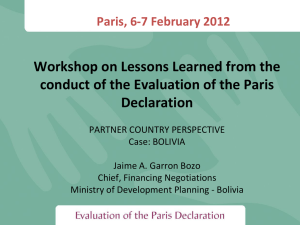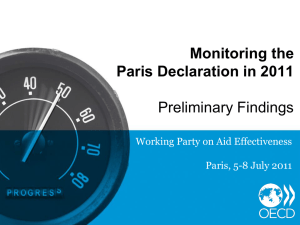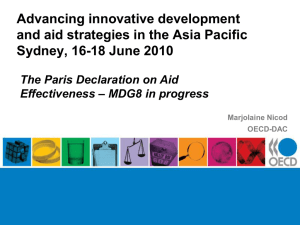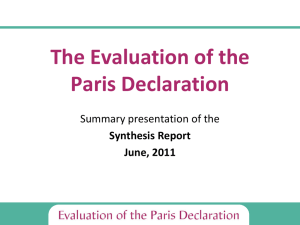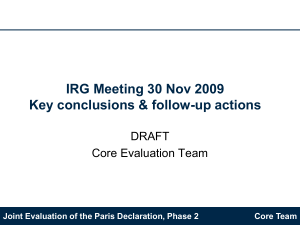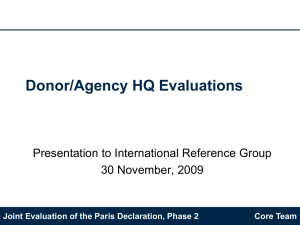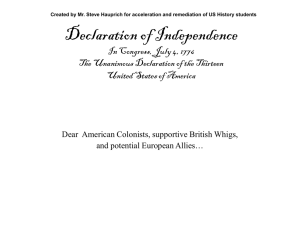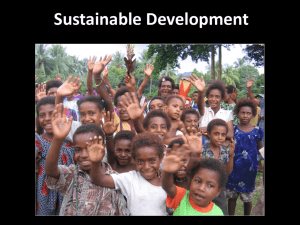Dabelstein_Speaker
advertisement
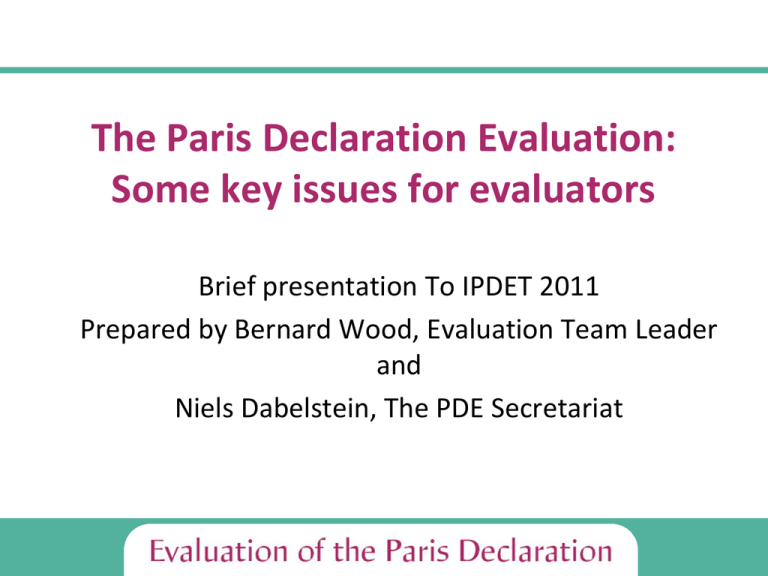
The Paris Declaration Evaluation: Some key issues for evaluators Brief presentation To IPDET 2011 Prepared by Bernard Wood, Evaluation Team Leader and Niels Dabelstein, The PDE Secretariat Topics covered • • • • Basics on the Evaluation Key Findings “Shop talk” for evaluators Sources of information and tools The Paris Declaration and this report • The Paris Declaration on Aid Effectiveness, endorsed in 2005, is a landmark international agreement and programme of reform – the culmination of several decades of attempts to improve the quality of aid and its impacts on development. • This Report is an independent global evaluation of these efforts to improve the effectiveness of international aid, especially since 2005 3 Background and process for the Evaluation Background • The Declaration itself pledged an independent evaluation - itself a tool for mutual accountability • A fully joint (and transparent) evaluation conducted over 4 years (Phase 1: 2007-8; Phase 2: 2009-11) Evidence base • 22 Country-level evaluations led by partner countries and managed in-country • 18 Donor/agency HQ studies • 7 Supplementary studies on key topics plus review of the most significant global literature 4 Evaluation components 5 Country Evaluations & Donor Studies 6 Governance and management • International Reference Group (50-plus reps. of governments, international Organizations and CSOs. Co-chaired by Malawi and Sweden) • Management Group (Colombia, Malawi, Netherlands, Sweden, US, Vietnam) • Evaluation Secretariat at DIIS • National/Agency Reference Groups and Evaluation Coordinators • National/Agency Evaluation Teams (with specified recruitment criteria, and common generic ToRs) • Core Evaluation Team (7 Members, from Canada, Denmark, Malawi Nigeria, Peru, Sri Lanka and the UK) • Peer Reviewers: Dr. Mary Chinery-Hesse and Mr. Mark Malloch-Brown. 7 The Key Evaluation Questions 1. “What are the important factors that have affected the relevance and implementation of the Paris Declaration and its potential effects on aid effectiveness and development results?” (The Paris Declaration in context) 2. “To what extent and how has the implementation of the Paris Declaration led to an improvement in the efficiency of aid delivery, the management and use of aid and better partnerships?” (Outcomes for aid effectiveness) 3. “Has the implementation of the Paris Declaration strengthened the contribution of aid to sustainable development results? How?” (Development outcomes) 8 The Key Messages: • The Paris Declaration has contributed to change of behaviour – but unevenly so. Partner countries have moved further and faster than donors. Some donors more than others and some very little. • The Paris Declaration has contributed to improve aid effectiveness – but much remains to be done. • The Paris Declaration has contributed to better development results – but not across the board. • The PD and AAA “campaign” remains relevant and has gained momentum – but needs nurturing to continue. 9 The Main Recommendations Five to policy makers in both partner countries and donor agencies and three to each of these groups separately. Some are not new – they may be seemingly obvious. But key political actions must be pressed again – simply and starkly – because they are so important and the Paris and Accra commitments that have not yet been met. 10 Strengths of Phase 2 • Evaluation Matrix developed for country studies, applying 11 outcomes of PD and AAA agreements. • Integrated evaluation quality assurance and peer review • Recognised the limits of aid in development and applied “contribution analysis.” • A targeted process of guidance & support, recognising the primary importance of country studies. • Good governance of the Evaluation at national and international levels ( with 52 member International Reference Group) ensured joint process and independence and validated the framework and findings at key stages. 11 Key limitations • Evaluating the effects of a political Declaration traditional ‘linear’ approaches were not relevant • Limited time elapsed since 2005 • No comprehensive data from country studies on multilaterals and donors • Self-selection of participating countries / agencies – some gaps but still a reasonably representative “sample” 12 Challenges & lessons for complex, comparative evaluations 1. A fully participatory and independent approach is possible, but demanding, and not cheap. It hinges on good governance arrangements, synchronization, communications and support 2. Context is not just “background” – it is of the essence and should be systematically analysed and featured 3. Finding the basic programme theory can be especially critical for very complex evaluation objects – and it may be hidden in plain sight 4. Key common questions can be developed to reflect most cases, then supplemented by special priorities for individual cases 5. Make the common evaluation framework feasible for all —a chain is only as strong as its weakest link 6. Where new approaches are required, anticipate capacity differences and needs for technical support to teams 13 Challenges & lessons ll 7. Contribution analysis, properly applied, is indispensable for evaluating many complex change processes 8. The pressure for rapid assessment and the necessary time to see outcomes have to be balanced - evaluators must state the limits 9. Delays in practical arrangements for different participants’ mandates, structures, terms of reference, contracting, and approval and release of reports can disrupt or derail the whole joint effort. Clear expectations, peer pressures and deadlines ultimately need to be backed by a readiness to move ahead without stragglers 10. For a multi-site evaluation, the development of ToRs and procurement of teams should be concurrent and the Synthesis process needs to be clarified from the start, in tandem with the common framework 11. Visibly ensuring independence is critical, particularly where potentially contentious findings are likely to emerge. This calls for strong procedures and standards, and clear governance 14 Full reports and supporting materials All documents from the Evaluation, including the full country evaluations and donor studies, can be found - in English, French and Spanish - on www.busanhlf4.org and www.oecd.org/dac/evaluationnetwork/pde Tools, templates and guidance materials (see Technical Annex to the Report) will also be made available on the DAC site Thank you for your attention 15 Supplementary slides for questions 16 Contributions to aid effectiveness • Pulled together and focused global attention on ambitious, experience-based measures to improve development cooperation and aid for better development results • Clarified the roles of ‘aid’ and ‘better aid’ • Strengthened global norms of good practice • Helped progress toward 11 key outcomes set in 2005, but very unevenly between actors and outcomes. • Improved the quality of aid partnerships - supported rising aid volumes and hopes for better “North-South” relations • Ranked the degree of difficulty in objectives. Found better progress among partner countries than among donors, who (with some striking exceptions) have been too uncoordinated and risk averse to play their full part 17 Examples of the range of performance against each intended improvement (From Fig. 5) 18 Contributions to Development Results Assessed in four key areas – health as a tracer sector, giving priority to the poorest, strengthening institutions and social capital, and a better mix of aid modalities. Assessed through a three-question sequence: – First, were development results achieved? – Second, did aid contribute? Other influences always more important. – Third, did aid reforms plausibly strengthen the aid contribution? (Contribution analysis a key tool) Considered relevance, unintended consequences, alternatives such as non-Declaration style aid, etc. 19 Contributions to Development Results 2 1. Results in specific sectors (health was the main case-study) Declaration type measures have contributed to more focused, efficient and collaborative aid efforts in health. These efforts have already contributed to better development results since 2000-05, and should be sustainable. The pathways of improvement are indirect but clear. Not wide enough coverage of other sectors to draw strong conclusions. 2. Priority to the needs of the poorest (especially women and girls) Little progress in most countries in delivering on these commitments. But evidence of some positive contributions by aid and some value-added by Declaration reforms. A powerful national commitment to change is a pre-requisite if aid is to help overcome entrenched inequalities. 20 Contributions to Development Results 3 3. Strengthening institutional capacities and social capital Insufficient capacity still a central obstacle to development - and aid could help more with this than it does. Modest contributions by aid and reforms to the long-term strengthening of institutional capacities. Clearer evidence for contributions to modest improvements in social capital. 4. Improving the mix of aid modalities Evidence that employing a wider range of (especially joint) modalities, has improved contributions to development results in half the countries – especially at sector level. A mix of aid modalities has continued to make sense for all actors. 21 Main Recommendations I A. For decision-makers in both partner and donor countries and agencies (at Busan and beyond): 1. Make the hard political choices and follow through 2. Focus on transparency, mutual accountability and shared risk management 3. Centre and reinforce the aid effectiveness effort in countries 4. Work to extend the aid reform gains to all forms of development cooperation 5. Reinforce the improved international partnerships in the next phase of reforms 22 Main Recommendations 2 B. For policymakers in partner countries: 1. Take full leadership and responsibility at home for further aid reforms 2. Set strategies and priorities for strengthening capacities 3. Intensify the political priority and concrete actions to combat poverty, exclusion and corruption C. For policymakers in donor countries and agencies: 1. Match the crucial global stakes in aid and reform with better delivery on promises made 2. Face up to and manage risks honestly, admit failures 3. Apply peer pressure to ‘free-riders’ for more balanced donor efforts A dozen key areas are identified for work beyond the Evaluation* 23
